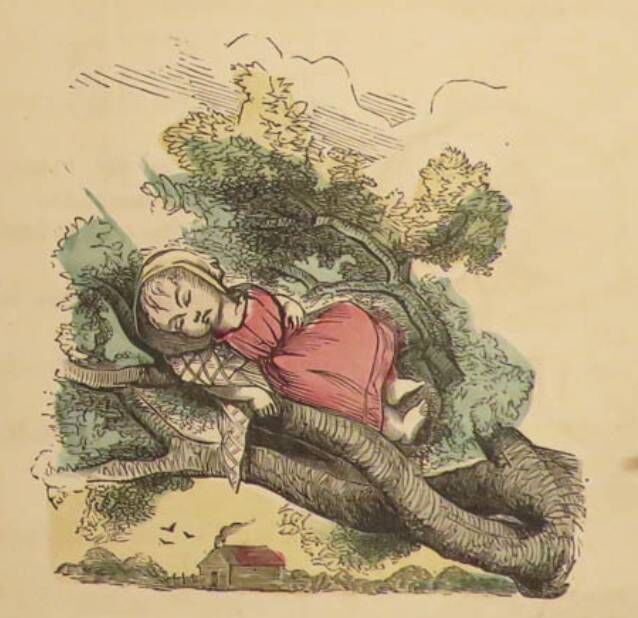Last year, a survey by the IB4UD blog included “Mary had a Little Lamb” and “Baa, Baa, Black Sheep” among Ireland’s Top 3 nursery rhymes. But it was “Twinkle, Twinkle, Little Star” — “mecca of all Irish nursery rhymes” — that achieved the top spot.
These days, nursery rhymes can be found in countries all over the world — from Bolivia to India, Kenya to the USA. But until a couple of hundred years ago, such songs, passed down by word of mouth since at least the 14th century, were known simply as ‘rhymes’, ‘lullabies’ or ‘ditties’ — and they were not written especially for children.
Many specimens are recorded in Tommy Thumb’s Pretty Song Book (1744), but the term ‘nursery rhyme’ appeared in print for the first time in the Edinburgh Review in July 1824, in an article by essayist and critic William Hazlitt, who praised the “rich imagination” behind “Four and Twenty Blackbirds”, and the “pictured poetry” of “Ride a Cock-horse to Banbury Cross”, in which you can almost hear the bells ringing. As for “Little Jack Horner”, he playfully ranked it right up there with anything in Shakespeare or Wordsworth. Nursery rhymes, he added, could teach children the benefits of thrift and hard work better than any lecture from Ricardo, and vividly demonstrate scientific principles, not least the law of gravity — what with falling cradles, and gigantic eggs tumbling off walls.
Professor Emer Ring, Dean of Early Childhood, MIC Limerick, agrees: “Playing with sounds in language has significant benefits for children’s learning and development”, and nursery rhymes are “one of the best and most fun” ways of doing this (A Trip Down Memory Lane, 2020). Who didn’t love singing “Two little dicky birds sitting on the wall, one named Peter, one named Paul. Fly away Peter, Fly away Paul…”
Dark origins
Many rhymes are associated with historical events, or famous people — though exactly which events and which people are highly questionable: who is “Mary, Mary, quite contrary”? Maybe not a sweet girl attending to her garden. She might be Mary Queen of Scots, or perhaps Queen Mary I. Did “silver bells” and “cockle shells” decorate the Scottish queen’s dress? Or were they torture instruments used by ‘Bloody Mary’ to crush the thumbs — and genitals — of Protestants?
As for “Little Jack Horner” who “pulled out a plum” from his Christmas pie, was he such a “good little boy”? Some reckon he was really Thomas Horner, steward of the Abbot of Glastonbury, who “pulled out a deed” from his master’s papers that he was meant to be taking to King Henry VIII in London.
Is “Ring-a-Ring o’ Roses” really about the Bubonic Plague? There are red skin rashes, scented posies, sneezing, and people falling down. But which plague: the Black Death (1348-49) that killed up to half the population of Europe, or the Great Plague of London (1665)? Maybe neither, for earlier versions of the song can be found in Germany, Italy, and Switzerland.
One theory goes that “Humpty Dumpty” is King Richard III — popularly thought to be hump-backed — who was defeated at the Battle of Bosworth Field (1485). The wall is his reign and fight to preserve power, the fall his defeat. But it’s also been suggested that Humpty was a massive cannon used by Royalist forces during the siege of Colchester (1648). For 11 weeks it blasted away at the attacking Roundheads from the tower of St Mary-at-the-Walls church. Its “great fall” came when the Roundheads blew the tower up, and it couldn’t be put together again. Without mighty Humpty, the king’s men were soon overrun.

Did Jack and Jill innocently go up the hill to fetch a pail of water, or were they two lovers from a Somerset village off to canoodle? Disaster struck. Jack fell, “broke his crown”, and had to bandage it with vinegar and brown paper. According to University of East London Librarian, Chris Roberts, the accident happened because Jack ran away “the minute he’d had his wicked way with Jill”. But maybe Jack and Jill are not people at all. In 1625, King Charles I reduced the size of a ‘Jack’ so he could collect more tax on whiskey and wine. Then he did the same with a ‘Jill’, which came “tumbling after”.

Disturbing lines
Whatever their tenuous origins, these seemingly innocent sing-along tunes reveal a wretched world of poverty and illness, persecution and murder. What’s more, they once contained — and sometimes still do — some thoroughly revolting images: a wife being sliced up and stuffed into a pumpkin shell (‘Peter, Peter Pumpkin Eater’), and blind men being “taken by the left leg” and “thrown down the stairs” (‘Goosey, Goosey, Gander’). As recently as the First World War, they included 21 deaths (by choking, decapitation, hanging, devouring, shrivelling and squeezing), 12 instances of animals being tormented, and references to eating human flesh, body snatching, and a desire “to have one’s own limb severed”.
Many distinctively Irish nursery rhymes are equally vile. The penniless ‘Old Mother Witch’ injures herself by falling into a ditch. ‘Where D’yer Come From? Donegal’ —suggests you can choke on potatoes. ‘Two Cats of Kilkenny’ scratch, bite, and tear each other to pieces. ‘Three Little Mice [who] Sat Down to Spin’ are duped by a pussycat who bites off their heads and leaves them “all dead on the floor”. And just when you think things couldn’t get any worse, ‘Paddy on the Railway’ is casually picking up stones, when he’s run over by an engine. And the driver doesn’t give a monkey’s!

In 1941, wealthy Manchester merchant Geoffrey Hall and author Geoffrey Handley-Taylor campaigned to clean up nursery rhymes, so as to stop children being corrupted by images of drowned cats in wells, babies’ cots strung high up in trees, and mutilated mice. Having removed the more “unsavoury elements”, Hall published his sanitised versions in New Rhymes for Old (1949). In “Ding Dong Bell”, Pussy is no longer “in the well” but “at the well”; and “who put her in?” is replaced by “who took her there?” The bough only “bends”, it does not “break”, and the cradle doesn’t “fall” in “Hush-a-bye Baby”. The farmer’s wife in “Three Blind Mice” is no longer a knife-wielding maniac who slashes off the tails.

However mysterious and politically incorrect these songs may sound today, one thing is clear: many of us once enjoyed chanting them. Hearing them again in later life evokes memories of a carefree, happy childhood. “We would give anything to recall those pleasant times”, observed William Hazlitt 200 years ago. Ahh! Who’d disagree? “Come back Peter, come back Paul!”
CONNECT WITH US TODAY
Be the first to know the latest news and updates







